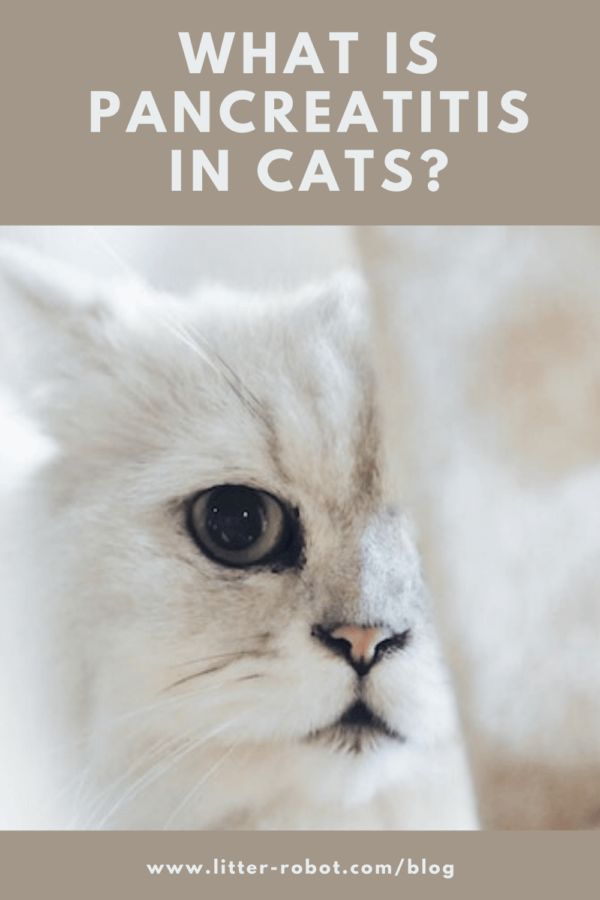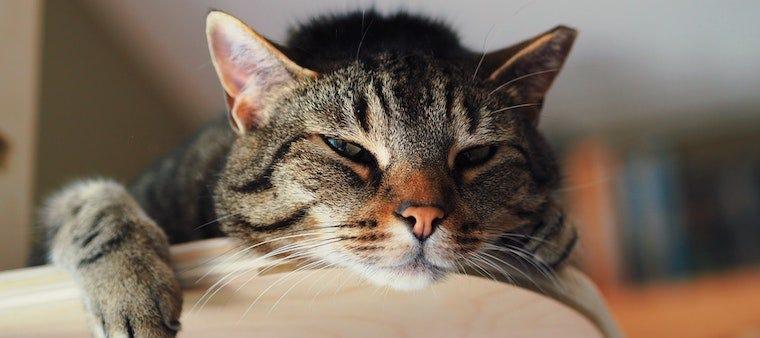If your cat was just diagnosed with pancreatitis, be aware that it’s a nebulous, often hard to diagnose medical problem in cats. Not only does it have a weird name, but it can be difficult to diagnose with just one “test” at your veterinarian. Let’s learn more about pancreatitis in cats and how to treat it.
What is feline pancreatitis?
Acute pancreatitis in cats is inflammation of the pancreas. The pancreas, which is located in the upper 1/3 of your cat’s abdomen, normally helps with digestion, breaks down fat in the gastrointestinal tract, neutralizes gastric acid in the stomach, and releases insulin (which is important for blood sugar/glucose regulation in the body). With sudden inflammation, the normal enzymes within this small organ start digesting itself; this results in severe secondary inflammation to the organ and surrounding tissue and abdominal space (called peritonitis).
As a result, pancreatitis in cats can range from mild (which can be treated on an outpatient basis) to potentially life-threatening (which requires 24-hour care and possible temporary feeding tubes). Without treatment, it can result in chronic scarring to the pancreas, diabetes mellitus, or even rarer endocrine disorders (e.g., exocrine pancreatic insufficiency).
What causes pancreatitis in cats?
The exact cause for pancreatitis in cats isn’t well known. It’s thought that obesity, underlying liver problems (such as cholangiohepatitis), and metabolic problems (such as inflammatory bowel disease, etc.) may be associated. That’s different from other species, as humans get pancreatitis from gallbladder stones, alcoholism, and drugs, while dogs typically get it from getting into a fatty meal (like a piece of bacon or leftover Thanksgiving dinner!). Less commonly, gallbladder problems, cancer (e.g., pancreatic adenocarcinoma, which my own cat died from), trauma, surgery, or even certain prescription medications can cause pancreatitis, too.
Clinical signs of feline pancreatitis
Signs of pancreatitis in cats can be really subtle, and often look similar to other problems (like vomiting up a hairball!). For that reason, it’s really important to seek veterinary attention immediately if your cat stops eating for more than 2-3 days and shows any of these clinical signs:
- Decreased appetite to not eating at all
- Listlessness (lying around more than usual)
- Vomiting
- Abdominal pain
- Hiding in unusual places (closet, basement, under the bed, etc.)
- Smaller urinary clumps or fecal bulk in the litter box (due to decreased appetite or not eating)
- A subtle yellow hue to the tips of the ears, eyes, and mouth (this is very difficult for pet parents to pick up on) secondary to hepatic lipidosis
- Diarrhea
- Fever or hypothermia
- Dehydration
- Weight loss – despite the obese state
- Muscle wasting (this is most commonly seen over the back muscles)
- An elevated respiratory rate
- Acting painful
How do you diagnose pancreatitis in cats?
Your veterinarian will need to run several tests to diagnose pancreatitis in your cat. Typically, a preliminary diagnosis of pancreatitis is based on history, clinical signs (such as not eating for several days), and blood work.
- A complete blood count (CBC) to evaluate the red and white blood cell count, along with the platelet count
- A biochemistry panel to evaluate the protein, electrolytes, kidney function, and liver enzymes
- A urinalysis to evaluate the urine/kidney function
- Specific blood tests to evaluate the function of the pancreas (e.g., Feline Pancreatic Lipase Immunoreactivity (PLI or fPLI) levels)
- X-rays to look at the size of the organs, heart size, gas patterns within the intestinal tract, etc.
- Abdominal ultrasound to look at the architecture or “inside” of the pancreas, liver, gallbladder, tubes from the gallbladder, etc., as X-rays can’t do this
- Autopsy (this is sadly done once a pet has passed away, and is seen on necropsy)
Keep in mind that the diagnosis of pancreatitis is often based on several tests and assessments together. As a veterinary specialist, I typically start with initial blood work and progress to an ultrasound, as I feel like it is the most accurate way of diagnosing pancreatitis. While the PLI tests are nice—as they are less expensive and only require a blood sample—they aren’t 100% accurate; sometimes an elevated test can be seen with gastrointestinal problems or even intestinal cancer.
Work with your veterinarian
When in doubt, work with your veterinarian to determine which tests are best and fit within your budget. Know that these tests can be costly (the ultrasound alone is typically $400-500, when done by a board-certified veterinary radiologist, which I recommend). That’s one of the reasons why I always advocate for pet insurance early in your cat’s life to help defray from the costs associated with illness. Once your cat is diagnosed with something, it’s considered a pre-existing condition, so won’t be covered by insurance later!
What’s the treatment for pancreatitis in cats?
The treatment for feline pancreatitis typically includes either subcutaneous (SQ) or intravenous (IV) fluids, pain medication (e.g., buprenorphine), proper nutritional supplementation, appetite stimulants (e.g., mirtazapine), and supportive care. With mild cases, treatment can be done outpatient, where your cat goes home with you that day. With moderate cases, hospitalization at your veterinarian is recommended.
In severe cases (such as when your cat has uncontrolled pain or signs of shock, low blood pressure, or sepsis), hospitalization at a 24/7 emergency specialty hospital may be recommended and often includes:
- Intravenous fluids to help hydrate the patient
- IV protein (e.g., Hetastarch) if the protein level is low
- Anti-vomiting medication
- Antacids
- Appetite stimulants (e.g., cyproheptadine or mirtazapine)
- Placement of a temporary feeding tube to provide adequate calories (this may be necessary for several weeks)
- Antibiotics
- Blood pressure monitoring
- Constant care for at least 48 hours
- Frequent monitoring of the electrolytes and liver values while hospitalized
- Symptomatic supportive care
- Vitamin K1 to help fix clotting problems, if abnormal (less common)
- Plasma transfusions, if clotting abnormalities are seen (rare)
- Surgery (if pancreatic abscesses, cysts, cancer, or gallbladder obstruction is seen)
What’s the outcome for pancreatitis?
With aggressive supportive care, the prognosis for pancreatitis is fair to good. Keep in mind that pancreatitis can be extremely costly to treat. With pancreatitis, the sooner you and your veterinarian diagnose it, the less expensive it is to treat. Untreated—or if treated too late—it can be fatal. Even with aggressive therapy, please also be aware that secondary complications can occur with pancreatitis, including hepatic lipidosis (inappropriate fat infiltration into the liver causing jaundice or yellowing of your cat’s skin), diabetes mellitus, extrahepatic biliary duct obstruction (which rarely may require surgery), or even sepsis (where bacteria enters the bloodstream). When in doubt, make an appointment with your veterinarian!
Cover photo by Chen Yi Wen on Unsplash






